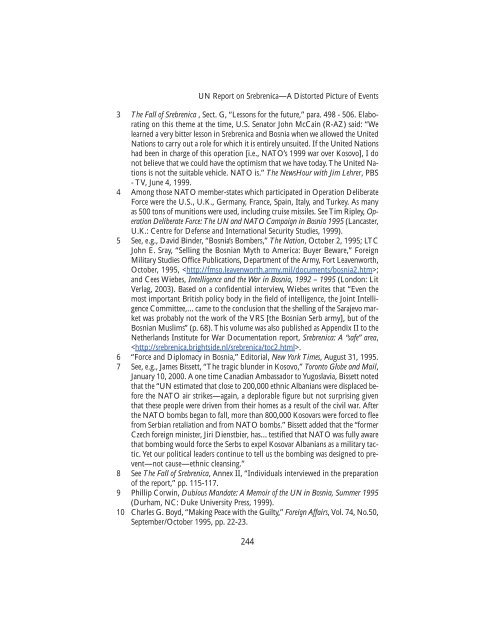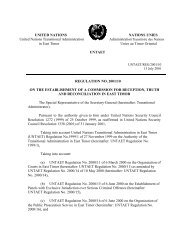The Srebrenica Massacre - Nova Srpska Politicka Misao
The Srebrenica Massacre - Nova Srpska Politicka Misao
The Srebrenica Massacre - Nova Srpska Politicka Misao
Create successful ePaper yourself
Turn your PDF publications into a flip-book with our unique Google optimized e-Paper software.
UN Report on <strong>Srebrenica</strong>—A Distorted Picture of Events<br />
3 <strong>The</strong> Fall of <strong>Srebrenica</strong> , Sect. G, “Lessons for the future,” para. 498 - 506. Elaborating<br />
on this theme at the time, U.S. Senator John McCain (R-AZ) said: “We<br />
learned a very bitter lesson in <strong>Srebrenica</strong> and Bosnia when we allowed the United<br />
Nations to carry out a role for which it is entirely unsuited. If the United Nations<br />
had been in charge of this operation [i.e., NATO’s 1999 war over Kosovo], I do<br />
not believe that we could have the optimism that we have today. <strong>The</strong> United Nations<br />
is not the suitable vehicle. NATO is.” <strong>The</strong> NewsHour with Jim Lehrer, PBS<br />
- TV, June 4, 1999.<br />
4 Among those NATO member-states which participated in Operation Deliberate<br />
Force were the U.S., U.K., Germany, France, Spain, Italy, and Turkey. As many<br />
as 500 tons of munitions were used, including cruise missiles. See Tim Ripley, Operation<br />
Deliberate Force: <strong>The</strong> UN and NATO Campaign in Bosnia 1995 (Lancaster,<br />
U.K.: Centre for Defense and International Security Studies, 1999).<br />
5 See, e.g., David Binder, “Bosnia’s Bombers,” <strong>The</strong> Nation, October 2, 1995; LTC<br />
John E. Sray, “Selling the Bosnian Myth to America: Buyer Beware,” Foreign<br />
Military Studies Office Publications, Department of the Army, Fort Leavenworth,<br />
October, 1995, ;<br />
and Cees Wiebes, Intelligence and the War in Bosnia, 1992 – 1995 (London: Lit<br />
Verlag, 2003). Based on a confidential interview, Wiebes writes that “Even the<br />
most important British policy body in the field of intelligence, the Joint Intelligence<br />
Committee,…came to the conclusion that the shelling of the Sarajevo market<br />
was probably not the work of the VRS [the Bosnian Serb army], but of the<br />
Bosnian Muslims” (p. 68). This volume was also published as Appendix II to the<br />
Netherlands Institute for War Documentation report, <strong>Srebrenica</strong>: A “safe” area,<br />
.<br />
6 “Force and Diplomacy in Bosnia,” Editorial, New York Times, August 31, 1995.<br />
7 See, e.g., James Bissett, “<strong>The</strong> tragic blunder in Kosovo,” Toronto Globe and Mail,<br />
January 10, 2000. A one time Canadian Ambassador to Yugoslavia, Bissett noted<br />
that the “UN estimated that close to 200,000 ethnic Albanians were displaced before<br />
the NATO air strikes—again, a deplorable figure but not surprising given<br />
that these people were driven from their homes as a result of the civil war. After<br />
the NATO bombs began to fall, more than 800,000 Kosovars were forced to flee<br />
from Serbian retaliation and from NATO bombs.” Bissett added that the “former<br />
Czech foreign minister, Jiri Dienstbier, has…testified that NATO was fully aware<br />
that bombing would force the Serbs to expel Kosovar Albanians as a military tactic.<br />
Yet our political leaders continue to tell us the bombing was designed to prevent—not<br />
cause—ethnic cleansing.”<br />
8 See <strong>The</strong> Fall of <strong>Srebrenica</strong>, Annex II, “Individuals interviewed in the preparation<br />
of the report,” pp. 115-117.<br />
9 Phillip Corwin, Dubious Mandate: A Memoir of the UN in Bosnia, Summer 1995<br />
(Durham, NC: Duke University Press, 1999).<br />
10 Charles G. Boyd, “Making Peace with the Guilty,” Foreign Affairs, Vol. 74, No.50,<br />
September/October 1995, pp. 22-23.<br />
244



